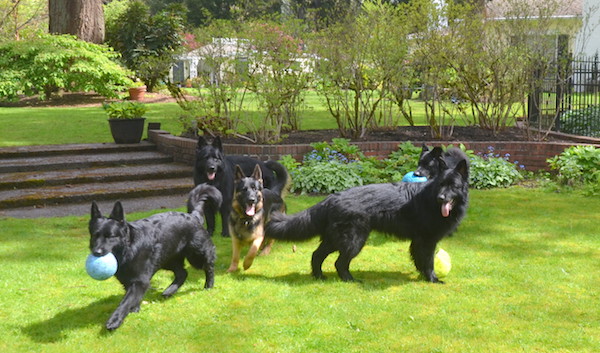
By Fran Jewell
We all remember that kid in school with a gang behind him that bullied someone who was a bookworm, or wore glasses, or even just didn’t have the cool clothes. The bully had to prove he or she was stronger, cooler, or just wanted a good laugh.
We are all aware of the cyber-bullying going on in schools now with the proliferation of cellphones, resulting in emotional devastation to the victims. Well, in the dog world, things are not much different. With the proliferation of overly-permissive dog “parenting,” excessive off-leash opportunities and lack of knowledge about what aggression really is, more and more dogs and puppies are being victimized by dogs who are bullies or, as I would call it, “pre-aggressive.”
Just what is dog bully behavior? It is when a dog runs up to another dog barking, his head high, and with his high tail. The tail can be wagging, but it is held high. A wagging tail is not necessarily a friendly tail. No, this is not “friendly” behavior. Friendly behavior would be a dog that saunters over softly, with a relaxed tail at about half-mast. The friendly dog will not run fast or bark or go straight on. Most of the time, the friendly dog will have a loose mouth with its tongue out in a pant. Dogs with their mouths closed or barking are a sure sign of bully behavior. Hackles are, of course, another sure sign of a bully dog and potentially aggressive behavior. Some hackles indicate excitement, others indicate fear.
When owners allow their dog to continue to run up to another dog, barking, with a high tail, they are in fact giving the dog permission to escalate into full-on aggressive behavior.
Proper behavior from an owner with an off-leash dog is to have their dog sit nicely next to them. Ask the other dog owner if the dogs can play and if their dog is friendly. If the other dog owner says, “Please keep your dog away! Mine is afraid of other dogs,” or “My dog is not social!” it is important to respect that.
A responsible and kind dog owner will respect other owners and their dogs. It is best to have your dog sit patiently until released to go play. Calm behavior should be rewarded with play. Do not reward bully behavior with allowing more bully events.
A part of teaching a dog that bully behavior is not acceptable is leadership in a manner that the dog understands, AT HOME. Leadership does not mean beating on a dog. It means that the dog understands that the owner makes the decisions. An owner is a dog’s “director,” not a dictator. That also means that the owner must accept that responsibility! ALL dog owners must realize that leaving decisions about behavior to the dog will result in feral behavior that may start with bullying, and then very quickly soar into aggression.
At home, the dog must learn that it is not permissible to bully the owner. Giving treats when the dog wants, demanding petting, barging through doors with no respect to the human, grabbing food out of someone’s hand, and even not getting off the sofa or bed when told to, giving a grumble, are all preludes to building a bully dog. While these things may seem innocuous or even cute, they can be preludes to more demanding and bully behaviors. A bully dog is never appreciated by other dogs or other humans.
Dogs are dogs. They are not humans and do not understand what is socially acceptable in our human world. Dogs must be taught what is acceptable in our society and not be left to their own devices. Every dog needs to learn self-control. The new language is “impulse-control.” It is then that dogs can coexist peacefully with other people and each other.
Fran Jewell is a dog behavior consultant, NADOI-certified instructor and vice president. She owns Positive Puppy Dog Training LLC and can be reached at (208) 721-7221.


